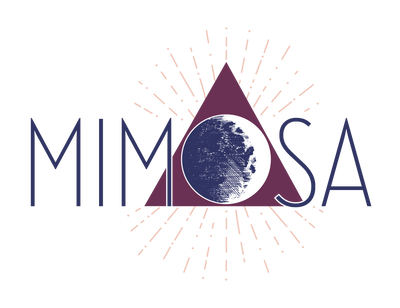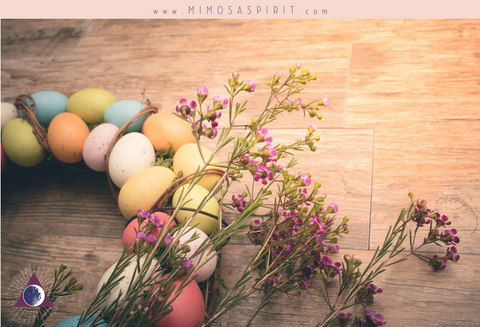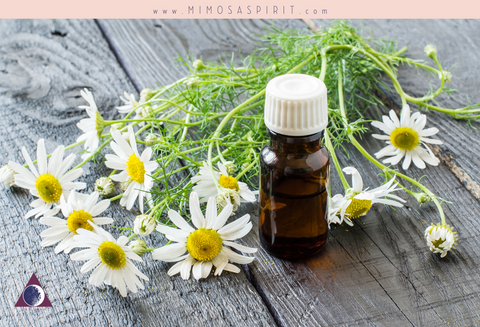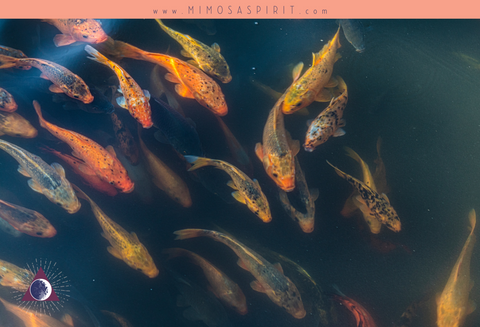
Brigid: Triple Goddess of the Flame (Health, Hearth, & Forge)
May 4th, marks the sacred day of the Celtic Festival honoring the goddesses Cerridwen and Brigid. It’s on this day that these goddesses are honored for their connection to healing, fertility, and the beautiful art of poetry.
Although Brigid is associated with the High Holy Day of Imbolc (when we celebrate her as a bringer of light), we also celebrate her on the 4th of May and honor her connection to fertility.
Brigid was seen as a powerful Queen, and belonged to the ancient Celtic tribe of Gods (the Tuatha De Danann) and in the Lebor Gabála Érenn she was identified as the daughter of Dagda (the great Father God of the Celts, known as the Chief of the Gods). In other tales, Brigid was said to be the daughter of Dubthach (A Druid), and a Christian mother, who brought her from Ireland to the Island of Iona (also known as the Druid’s Isle).
It’s said that when Brigid was born at sunrise in the town of Faughart, she ascended into the sky along with the sun, and that rays of fire and light shone forth from her head in a tower of flame that reached up to the heavens. The event of her birth was said to be so bright that the family household looked as if it were on fire. As an infant, she was fed the milk of a sacred cow from the Celtic Otherworld, so she is still often associated with cattle and milk.
It’s said that Brigid looked after an apple orchard in the Celtic Otherworld (apples symbolize wisdom, healing, and magic). Here, she communed with the bees, who would bring the magical, healing nectar back to earth. Because of Brigid’s connection to healing and fertility, it’s said that flowers or shamrocks would spring up from the earth in her footsteps wherever she walked. Additionally, Brigid’s connection to cattle and livestock (and her protection of domesticated animals) comes from the legend that she possessed two oxen (named Fe and Men), a boar (named Torc Triath), and a sheep (named Cirb). It’s said these animals would cry out with warnings of protection if danger was near.
Sometimes Brigid is represented as three sisters or as three mothers, but these are most commonly viewed as individual aspects of Brigid as a triple goddess. This idea dates back to reference of Brigid in Cormac's Glossary (written in the 10th century by Christian monks).
The three aspects of the Triple Goddess Brigid are:
- Goddess of healing and herbs
- Goddess of smithing and building (represented by the anvil and the forge)
- Goddess of midwifery and fertility (of people and of crops)
Brigid is seen as a keeper of the light and is often pictured holding a flame in the palm of her hand. The light from her flame warms hearth and home (Fire of the Hearth), heats the forge (Fire of the Forge), and sparks inspiration in poets (Fire of Inspiration) - this flame is representative of all 3 of her triple goddess aspects.
In her first aspect as healer, Brigid is often shown with a satchel of healing herbs, bees, and flowers. In this aspect she’s also connected with the water element (as she’s strongly connected to natural springs and healing wells). Ancient healers and herbalists were keepers of great knowledge and wisdom. It’s through this aspect that we also see Brigid’s relationship to scholarship and learning (especially poetry and history), as well as her ties to vision, dreams, and prophecy (augury). Here Brigid is revered as a Muse who sparks inspiration in poetry and song.
In her second aspect as a fertility goddess, Brigid is often associated with childbirth, corn (and other crops), and livestock. Corn dollies are often made in her image and are called “Little Bride’s.” In her fertility aspect, she’s also called upon for protection (especially of mothers and children). It’s said that Goddess Brigid leans over every cradle, protecting babies and children. It is here that we see Brigid’s connection with the hearth and home. Brigid’s connection to the home extends far beyond fertility. She’s also connected to cleansing (often represented by the witch’s broom or besom), weaving and embroidery, and harmony.
In her third aspect as goddess of the forge, Brigid’s connection to smithing and building is predominant. Brigid’s knowledge of metalsmithing was incredible - in one legend she made a whistle that could be used at night to transport someone to be with another person. It’s this aspect that is responsible for Goddess Brigid’s connection to the strength and protection of warriors. It is in her role as goddess of the forge that Brigid oversees justice, law, and order.
In fact, Brigid was the wife of Bres (an Irish King), and together they had three sons who all became famous warriors. Brigid was seen as a patron deity of warfare, and her warriors were known as Brigands. This lasted until one of Brigid’s sons, Ruadan, was struck down by the Smith God Giobhniu at the second battle of Magh Tuireadh. Upon his death, Brigid’s grief was heard so far and wide that both sides left the battle, and instead of forging weapons, forged a lasting peace instead. It’s said that it was Brigid’s grief for her son that created the act of keening (singing cries of grief and lament). Brigid later came to be seen as a symbol of peace and unity.

Brigid was long revered by the Celts in pre-Christian Ireland, but was later converted to a Saint by the Catholic church, in about 453 CE, and is still honored across many of Ireland’s sacred, healing wells (which have been in use for thousands of years) by both Christians and non-Christians alike. The goddess was converted to a Saint when members of the church realized that it would be difficult (if not impossible) to convert the Celtic pagans to Christianity without a way for them to continue to worship their beloved mother goddess, Brigid. The new Saint Brigid of Kildare even kept most of her same correspondences as the Goddess Brigid.
Water, like that flowing at the sacred wells, is symbolically linked to the Celtic Otherworld and was seen as a portal or gateway between realms. The custom of throwing coins into a wishing well may even be linked to the Goddess Brigid. It was thought that Brigid would reward those who made offerings to her, so coins and other silver offerings were often tossed into her sacred wells to curry favor with the goddess (a tradition that lasts to this day). Even now, if you visit any of Brigid’s sacred wells in Ireland, you’ll see offerings of rosary beads, clootie ribbons, coins, candles, and more - all left in honor of Goddess Brigid. In pre-Christian times, these wells were often decorated with flowers and greenery.

It’s said that it was Brigid who taught the people of Ireland about the healing properties of herbs and plants, how to care for cattle and livestock, and how to forge iron and smith tools. There’s an ancient Oak tree near Brigid’s well in Kildare that was revered by the Druids. This tree marks the spot where this teaching was said to have taken place. This Oak tree (now gone) is the site of an ancient gathering place of priestesses (or of a monastery of nuns in the Christian version of the story) who each spent 30 years of their lives in devotion to Brigid. During the first ten years, these priestesses received special training in the ways of the goddess. During the next ten years, they would tend the sacred wells and fertile lands of the goddess. Their final ten years were spent passing on their wisdom and knowledge by training others.

At her sacred well in Kildare, an eternal flame is still tended to this day by devotees of Saint Brigid. The pre-Christian priestesses who started this tradition were known as Inghean au dagh (the Fire Keepers). According to the ancient Irish text, Giraldus Cambrensis, there were traditionally 19 priestesses who would tend the sacred flame, one per day for 19 days, by feeding it the sacred wood of the Hawthorn tree. The number 19 was sacred to Brigid because, according to the Book of Dunn Cow, it represents the 19-year cycle of the Great Celtic Year and the time it takes for the new moon to coincide with the Winter Solstice from one cycle to another.
It’s said on each 20th day, the Goddess Brigid herself tends the flame to keep the fire burning brightly. The sacred flame was originally kept within a hedge which no men were permitted to enter (lest they risk insanity or death upon entering). The sacred flame was extinguished once in the thirteenth century and then again during the persecution of the monasteries by Henry VIII. The flame wasn’t re-lit until February 2nd, 1996 when Sister Mary Minchin, a Brigedian nun at Kildaire, relit the flame with the intention of keeping it burning once again.
It’s here at her well in Kildare that Brigid was said to have agreed to heal two lepers. When they came to her seeking help, she asked them to bathe one another in the healing waters of the well until they were each healed. One leper bathed the other until he was healed, but after having been cured, the healed man, disgusted by the other, refused to bathe him in return. Upon discovering what had happened, Brigid was enraged and caused the man’s leprosy to return. She then took pity on the shunned man and draped her cloak around his shoulders, healing him instantly.
Historically, there’s a record of a woman named Darlughdacha who was said to have become the abbess of Kildare monastery upon Brigid’s death. The name Darlughdacha means “Daughter of Lugh” and the Catholic list of Saints lists her Feast Day as February 1st (Imbolc - the primary Feast Day of Goddess Brigit). It’s speculated that Darlughdacha was the historical figure associated with the Goddess Brigid and that “Brigid” was actually a title (meaning Exalted One), rather than the actual name of the Goddess.

Her presence is often represented by displaying “Saint Brigid’s Cross,” a cross woven of reeds (or often three or four sheaves of wheat) joined at a square center, that’s hung in the home as a symbol of protection, fertility, abundance, and blessings. When the pre-Christian goddess was converted to a Saint by the Catholic church, devotees to Goddess Brigid hung this woven cross in their homes as a secret way of worshipping her after Ireland became predominantly Catholic. It’s common to make a new cross each Imbolc.

Brigid’s connection with Imbolc is no coincidence...as a goddess of the fire and the sun, her presence is felt at this time of year when the cold days of winter are mostly behind us and we begin to welcome in the warmth and light of spring. An Imbolc custom to honor the Goddess Brigid is carried out by women at La Fheill Brighid. Here, on this day, an image of Brigid in her Maiden form is created, dressed in white, and placed in a woven basket (representative of a cradle). A crystal is placed over her heart (representing her purity), and the goddess is invited into the home by the female head of the household by singing sacred songs and chants to welcome her.

There’s a reference, in the Carmina Gadelica, to Brigid’s connection to La Fheill Brighid, describing how a serpent came out of the mound here (the serpent, being a symbol of healing, has long been linked to Goddess Brigid). It’s said that this serpent emerges from the mound early in the morning each Imbolc in honor of the goddess.
One final Imbolc tradition to honor Goddess Brigid is to leave a loaf of bread, a pitcher of milk, and a candle out for her on this day. In Avebury, Brigid devotees climb the Silbury Hill (a neolithic earthen mound) to eat fig cakes and water in honor of Brigid.
May the fire of Goddess Brigid spark inspiration within you today and always!
Brigid’s Colors:
- Blue
- Green
- Gold
- Orange
- Red
- White
- Yellow
Brigid’s Crystals:
Brigid’s Symbols:
- Acorn
- Anvil
- Apple
- Bee
- Brigid’s Cross
- Broom (Besom)
- Cauldron
- Celtic Cross
- Cow (especially white with red ears)
- Corn Dolly (Little Bride)
- Daffodil
- Dandelion (Little Notched of Bride)
- Ear of Corn
- Ewe
- Fire
- Grain
- Hammer
- Herbs
- Lamb
- Linnett/Oyster Catcher (Little Bird of Bride)
- Mantle (Shawl/Cloak)
- Milk
- Nettle
- Oak Leaf
- Rowan
- Seashell
- Serpent/Snake (especially 2 intertwined)
- Shield
- Spinning Wheel
- Stone (bright and sparkling)
- Sun
- Swan
- Sword
- Triple Flame (especially within a heart)
- Water
- Well
- Wheat
- White Willow
Suggested Offerings to Brigid:
- Bread (baked fresh and served with lots of butter and berries)
- Candles (Blue, Gold, Green, or White)
- Feathers (Blue, White, or Yellow)
- Flowers (Daffodils or Dandelions)
- Herbs (fresh or dried, or brewed as herbal tea)
- Incense (Bergamot, Cinnamon, or Vanilla)
- Music (especially Celtic harp)
- Water (collected from a spring or fresh stream)
- Willow Branch Wand
Best Times to Honor Brigid:
- Imbolc (February 1st)
- Celtic Rowan Moon (the Night of the Full Moon in February)
- Celtic Festival Honoring Brigid as a Corn/Fertility Goddess (May 4th)
- Celtic Willow Moon (the Night of the Full Moon in May)
Brigid’s Alternative Names:
- Braint
- Breda
- Breed
- Breege
- Breint
- Breo-Saighit (the Flame of Ireland/Fiery Arrow)
- Brid
- Bride
- Bride of Joy
- Bridget
- Bridgit
- Bridie
- Brigandu
- Brigantia
- Brigdu
- Brighde
- Brighid
- Brighid Binne Bheule Lhuchd Nan Trusganan Uaine (Song-sweet/Melodious-mouth'd Brighid of the Tribe of the Green Mantles)
- Brighid Nam Bhatta
- Brighid of Prophecy
- Brighid of Pure Love
- Brighid of the Dedannans
- Brighid of the Harp
- Brighid of the Sorrowful
- Brighid Muirghin Na Tuinne (Brighid Conception of the Waves)
- Brighid Nan Sitheachseang (Brighid of the Slim Fairy Folk)
- Brighid Sloigh (Brighid of the Immortal Host)
- Brighid Sluagh (Brighid of the Immortal Host)
- Brighid the White
- Brighit
- Bringinda
- Brigit
- Brigitania
- Brittania
- Cú-gorm
- Ffaid
- Lady of the Dawn
- Lady of the Shores
- Lady of the Threshold
- Moon Crowned Brighid of the Undying Flame
- Muime Chriosd (Foster Mother of Christ)
- Saint Bride of the Isles
- Saint Bride of the Mantle
- Saint Briget
- Saint Brigid
- Sireadh Thall
- Suibhal Bheann
Sources & Further Reading:
- A Brigit of Ireland Devotional: Sun Among Stars by Mael Bridge
- Brighid’s Healing: Ireland’s Celtic Medicine Traditions by Gina McGarry
- Brigid: Celtic Saint and Celtic Goddess by Joy Reichard
- Brigid: Goddess, Druidess and Saint by Brian Wright
- Brigid: History, Mystery, and Magick of the Celtic Goddess by Courtney Weber
- Brigid: Meeting the Celtic Goddess of Poetry, Forge, and Healing Well (Pagan Portals) by Morgan Daimler
- Brigid’s Light: Tending the Ancestral Flame of the Beloved Celtic Goddess by Cairelle Crow and Laura Louella
- Imbolc: Rituals, Recipes & Lore for Brigid’s Day (Llewellyn’s Sabbat Essentials) by Carl F. Neal
- Saint Brigid of Kildare: Life, Legend and Cult by Noel Kissane
- Saint Brigid, the Celts and the Early Irish Church by Justin R. McCarthy
- Tending Brigid’s Flame: Awaken to the Celtic Goddess of Hearth, Temple, and Forge by Lunaea Weatherstone
- The Goddess Brigid by Russel Knowles
- https://en.wikipedia.org/wiki/Brigid
- https://www.sacred-texts.com/neu/celt/cg1/cg1074.htm
Disclosure: The link here is an affiliate link, meaning I may earn a commission if you click through and make a purchase. Yay!






0 comments